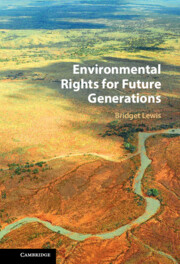Refine search
Actions for selected content:
1102 results
Social Innovation and Poverty Reduction: A Stakeholder Mobilization Process Model
-
- Journal:
- Management and Organization Review , First View
- Published online by Cambridge University Press:
- 20 November 2025, pp. 1-22
-
- Article
-
- You have access
- Open access
- HTML
- Export citation
12 - Doughnut Privacy
- from Part III - Technology and Policy
-
-
- Book:
- Being Human in the Digital World
- Published online:
- 11 November 2025
- Print publication:
- 20 November 2025, pp 185-204
-
- Chapter
-
- You have access
- Open access
- HTML
- Export citation

The State of Nature and the Shaping of Modernity
- Tracing the Roots of Colonialism, Secularity, and Ecology
-
- Published online:
- 19 November 2025
- Print publication:
- 18 December 2025
1 - Introduction
-
- Book:
- States of Transition
- Published online:
- 31 October 2025
- Print publication:
- 13 November 2025, pp 1-24
-
- Chapter
- Export citation
10 - Threads That Last
- from Part IV - Looking Ahead
-
-
- Book:
- Fashion and Intellectual Property
- Published online:
- 27 October 2025
- Print publication:
- 13 November 2025, pp 283-315
-
- Chapter
-
- You have access
- Open access
- HTML
- Export citation
8 - Fashion Upcycling and Trademark Infringement
- from Part III - Current Trends
-
-
- Book:
- Fashion and Intellectual Property
- Published online:
- 27 October 2025
- Print publication:
- 13 November 2025, pp 217-251
-
- Chapter
-
- You have access
- Open access
- HTML
- Export citation
Values and commitment in the innovation process in highly regulated and semi-public systems: The case of the four-day work week in German healthcare
-
- Journal:
- Journal of Management & Organization , First View
- Published online by Cambridge University Press:
- 05 November 2025, pp. 1-19
-
- Article
-
- You have access
- Open access
- HTML
- Export citation
Silent Conversations: Environmental Agent Reflexivity for Climate Change Action in Indonesian Schools
-
- Journal:
- Australian Journal of Environmental Education , First View
- Published online by Cambridge University Press:
- 05 November 2025, pp. 1-19
-
- Article
-
- You have access
- Open access
- HTML
- Export citation
Transformative just transition as redistribution of income and wealth
-
- Journal:
- The Economic and Labour Relations Review ,
- Published online by Cambridge University Press:
- 20 October 2025, pp. 1-15
-
- Article
-
- You have access
- Open access
- HTML
- Export citation
Blockchain and its future in the supply and value chains of the dairy industry
-
- Journal:
- Journal of Dairy Research , First View
- Published online by Cambridge University Press:
- 16 October 2025, pp. 1-8
-
- Article
-
- You have access
- HTML
- Export citation
Overwhelming Complexity? Entering a New Era of Microbial Governance
- Part of
-
- Journal:
- Public Humanities / Volume 1 / 2025
- Published online by Cambridge University Press:
- 16 October 2025, e146
-
- Article
-
- You have access
- Open access
- HTML
- Export citation

Environmental Rights for Future Generations
-
- Published online:
- 11 October 2025
- Print publication:
- 30 October 2025
15 - One Health and Multispecies Urban Infrastructure
- from Part III - One Health and Future Legal Structures
-
-
- Book:
- The Cambridge Handbook of One Health and the Law
- Published online:
- 25 September 2025
- Print publication:
- 09 October 2025, pp 230-243
-
- Chapter
- Export citation
Pasture cropping for sustainable agricultural production in African drylands
-
- Journal:
- Cambridge Prisms: Drylands / Volume 2 / 2025
- Published online by Cambridge University Press:
- 09 October 2025, e11
-
- Article
-
- You have access
- Open access
- HTML
- Export citation
Micro-entrepreneurs towards the twin sustainable and digital transition. Does financial literacy play a role?
-
- Journal:
- Journal of Financial Literacy and Wellbeing ,
- Published online by Cambridge University Press:
- 06 October 2025, pp. 1-21
-
- Article
-
- You have access
- Open access
- HTML
- Export citation
Conclusion and Epilogue
-
- Book:
- An Economic History of Europe
- Published online:
- 02 October 2025
- Print publication:
- 02 October 2025, pp 275-287
-
- Chapter
- Export citation
A survey of route optimisation and planning based on meteorological conditions
-
- Journal:
- The Aeronautical Journal , First View
- Published online by Cambridge University Press:
- 01 October 2025, pp. 1-26
-
- Article
-
- You have access
- Open access
- HTML
- Export citation
Water Sustainability among Secondary Education Teachers: Perspectives from Two Hispanic Cities
-
- Journal:
- Australian Journal of Environmental Education , First View
- Published online by Cambridge University Press:
- 01 October 2025, pp. 1-16
-
- Article
-
- You have access
- Open access
- HTML
- Export citation
A study protocol for interprofessional collaborative, digital, and sustainability training in primary healthcare: the REALISE study
-
- Journal:
- Primary Health Care Research & Development / Volume 26 / 2025
- Published online by Cambridge University Press:
- 30 September 2025, e83
-
- Article
-
- You have access
- Open access
- HTML
- Export citation
Modeling the greenhouse gas emissions of an immunization program against respiratory syncytial virus in infants in the United Kingdom
- Part of
-
- Journal:
- International Journal of Technology Assessment in Health Care / Volume 41 / Issue 1 / 2025
- Published online by Cambridge University Press:
- 22 September 2025, e73
-
- Article
-
- You have access
- Open access
- HTML
- Export citation
